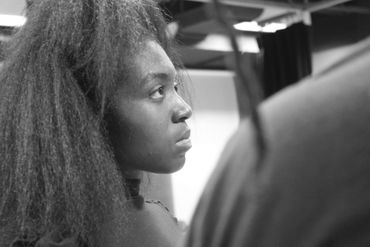.png/:/cr=t:0%25,l:0%25,w:100%25,h:100%25)
02/2023 - 06/2023
Silhouettes: Cut to Black - The Kara Walker project
Director, Project Concept
Project Overview
Silhouettes: Cut to Black- The Kara Walker Project, a community engagement project with ROUGE productions hosted at the Virginia Museum of Contemporary Art (MOCA) and Virginia African American Cultural Center.
From a 4-week rehearsal process, this ensemble-based devised theatre work culminating in a moving performance demonstrating some of the ways Walker's work resonates today in our region of Coastal Virginia.
Director: Brittney S. Harris
Producer(s): Patrick K. Mullins, Martha Goode
Cast: Ashlee Rey, Isis Marné, Leila Stephanie, and Nyaira Jones
Directorial Approach & Statement
Methodological Approach(es): Exploring the thematic elements of :
- Augusto Boal’s Theatre of the Oppressed: Image Theater work
- Specific thematic/physical elements of Kara Walker's artistic exploration of black bodies in distress and liberation through narrative.
- The Umbrella Method ( an original concept for devising narrative-based solo and ensemble theatre works)
Silhouettes: Cut to Black continues my creative research agenda of identifying narratives of resilience and resistance within BIPOC communities. This project will serve as an active dialogue not only for the performers but for the audience as well. Her works causes you seek beyond the image, invoking some internal inventory that truthful as a very visceral reaction…and embodiment. This interactive piece will call for scene-to-scene participation, leaving each performance purely unique and undefined.
Practical Application: Image Theater
Theatre of the Oppressed: Image Theater
Theatre of the Oppressed, which can be seen as a theatrical/performative form of activism, uses theatre as the means of promoting social and political change:
“Theatre is a language through which human beings can engage in active dialogue on what is important to them and allows individuals to create a safe space that they may inhabit in groups and use to explore the interactions which make up their lives. It is a lab for problem-solving, for seeking options, and for practicing solutions.” (1)
Practical Application
This project will not only serve as an active dialogue for the performers but for the audience as well. This interactive piece will call for scene-to-scene participation leaving each night of performance purely unique and undefined. While the rehearsal process is dedicated to the development of the prose, poetry, scenes, and/or choreography focused on various issues, the second major component of the production is the implementation of the Boalian exercise of the Image Theatre.
This unique method uses still images are used to explore abstract concepts, such as relationships and emotions, as well as realistic situations. These images are then placed together and ‘dynamized’ or brought to life. The method is often used to explore internal or external oppression, unconscious thoughts, and feelings.
(1) Augusto Boal and Adrian Jackson, The Aesthetics of the Oppressed (London: Routledge, 2006).
Silhouettes: Cut to Black [Production video]
Watch Silhouettes: Cut to Black- The Kara Walker Project, an ensemble-based performance, performed by Ashlee Rey, Isis Marné, Leila Stephanie, and Nyaira Jones, April 2023.
Directed by Brittney S. Harris
Image Gallery
Featured a) performance photos and b) in-person rehearsals, script development sessions of upcoming project.
.png/:/rs=w:370,cg:true,m)














Copyright © 2025 Brittney Simone Harris - All Rights Reserved.